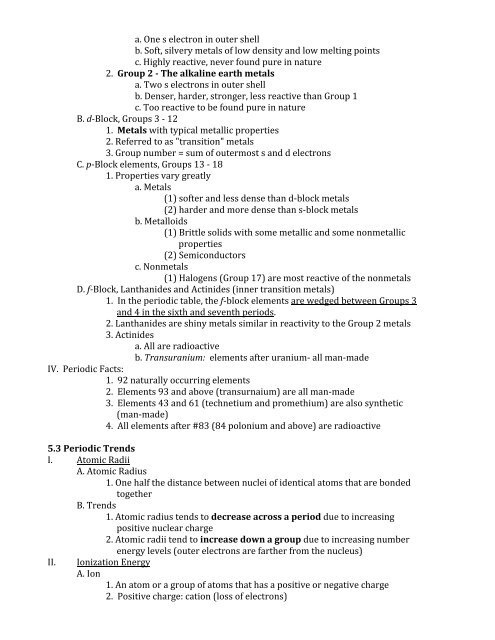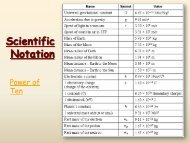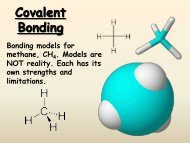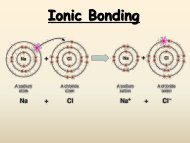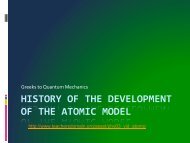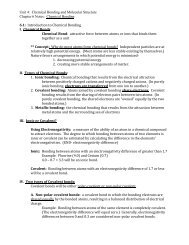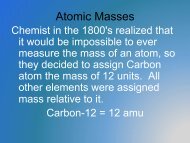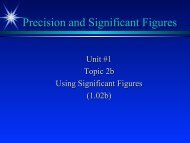Chapter 5: The Periodic Law 5.1 History of the Periodic Table I. M
Chapter 5: The Periodic Law 5.1 History of the Periodic Table I. M
Chapter 5: The Periodic Law 5.1 History of the Periodic Table I. M
- No tags were found...
Create successful ePaper yourself
Turn your PDF publications into a flip-book with our unique Google optimized e-Paper software.
a. One s electron in outer shell b. S<strong>of</strong>t, silvery metals <strong>of</strong> low density and low melting points c. Highly reactive, never found pure in nature 2. Group 2 -‐ <strong>The</strong> alkaline earth metals a. Two s electrons in outer shell b. Denser, harder, stronger, less reactive than Group 1 c. Too reactive to be found pure in nature B. d-‐Block, Groups 3 -‐ 12 1. Metals with typical metallic properties 2. Referred to as "transition" metals 3. Group number = sum <strong>of</strong> outermost s and d electrons C. p-‐Block elements, Groups 13 -‐ 18 1. Properties vary greatly a. Metals (1) s<strong>of</strong>ter and less dense than d-‐block metals (2) harder and more dense than s-‐block metals b. Metalloids (1) Brittle solids with some metallic and some nonmetallic properties (2) Semiconductors c. Nonmetals (1) Halogens (Group 17) are most reactive <strong>of</strong> <strong>the</strong> nonmetals D. f-‐Block, Lanthanides and Actinides (inner transition metals) 1. In <strong>the</strong> periodic table, <strong>the</strong> f-‐block elements are wedged between Groups 3 and 4 in <strong>the</strong> sixth and seventh periods. 2. Lanthanides are shiny metals similar in reactivity to <strong>the</strong> Group 2 metals 3. Actinides a. All are radioactive b. Transuranium: elements after uranium-‐ all man-‐made IV. <strong>Periodic</strong> Facts: 1. 92 naturally occurring elements 2. Elements 93 and above (transurnaium) are all man-‐made 3. Elements 43 and 61 (technetium and promethium) are also syn<strong>the</strong>tic (man-‐made) 4. All elements after #83 (84 polonium and above) are radioactive 5.3 <strong>Periodic</strong> Trends I. Atomic Radii A. Atomic Radius 1. One half <strong>the</strong> distance between nuclei <strong>of</strong> identical atoms that are bonded toge<strong>the</strong>r B. Trends 1. Atomic radius tends to decrease across a period due to increasing positive nuclear charge 2. Atomic radii tend to increase down a group due to increasing number energy levels (outer electrons are far<strong>the</strong>r from <strong>the</strong> nucleus) II. Ionization Energy A. Ion 1. An atom or a group <strong>of</strong> atoms that has a positive or negative charge 2. Positive charge: cation (loss <strong>of</strong> electrons)


